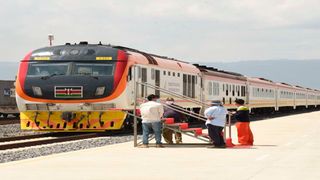
A train arrives at the Naivasha inland container depot at Maai Maihu, Nakuru County, in 2020.
| File | Nation Media GroupNews
Premium
New railway link to move cargo six times faster
What you need to know:
- Besides serving Uganda directly, the link also serves South Sudan, Burundi, Rwanda and DRC.
- In Kenya, the link will ensure that the Mombasa port becomes more efficient.
At the Naivasha Inland container depot, three standard gauge and two metre gauge rail tracks run side by side.
The standard gauge railway (SGR) tracks connect Naivasha to Mombasa, while the refurbished metre gauge rail (MGR) tracks connect Naivasha to Malaba. They are referred to as the SGR/MGR link.
At 9.30am, on Monday, an SGR cargo train loaded with 54 containers docks on the first track. On a platform, a crane and a lorry wait side by side. Ten minutes later, another cargo train docks on the MGR track. Its wagon is empty. On a platform on its side, another crane awaits.
A crane picks up a container from the SGR train wagon, and loads it onto the truck. The truck leaves as another takes its place, and then it makes its way to the opposite platform near the MGR track, where another crane picks up the containers and loads them onto the wagons. And the truck goes back to fetch more containers.
One hour later, the MGR train wagon is full, and the train driver awaits clearance to leave for Malaba, 18 hours away. Unlike on the MGR train, it takes nine hours to ferry cargo from Mombasa to Naivasha on the SGR line.
Factoring in the one hour offloading and loading time, the travel time for cargo from Mombasa to Malaba will take 28 hours, as opposed to the 72 hours it previously took.
Transporting cargo
This, notes Mr Philiph Mainga, the managing director of Kenya Railways Corporation, has enabled the depot to be a trans-shipment hub for East Africa’s cargo.
Speaking during a media tour at the depot, Mr Mainga said the new SGR/MGR link will move cargo six times faster by rail than by road from Mombasa to Malaba. The tour comes barely a week after inspection by President Uhuru Kenyatta.
“Currently it takes approximately seven days to transport cargo by road from Mombasa to Malaba. With the new SGR-MGR link, we will cover the same distance by rail in just 28 hours. This means that for every trip a truck does from Mombasa to Malaba, a train will have done six trips,” he said.
Should a trader choose to use rail over road to transport their cargo from Mombasa to Malaba, they will save up to Sh120,000 per container, noted Mr Mainga. It costs Sh200,000 per container to move cargo by road, and between Sh86,000 and Sh90,000 using the new rail link.
“This means that for every two shillings spent transporting cargo from Mombasa to Malaba by road, one shilling will be spent by railway,” said Mr Mainga.
“We have done trans-shipment of three cargo trains; one carried exports from Kampala through Malaba to Mombasa through this facility, and we have trans-shipped two import trains from this facility all the way to Malaba and Kampala. They were all successful,” he explained.
Decongesting roads
Besides serving Uganda directly, the link also serves South Sudan, Burundi, Rwanda and DRC. In Kenya, the link will ensure that the Mombasa port becomes more efficient, and that transit cargo that goes by road is reduced.
“Normally, our transit cargo that comes from Mombasa by road accounts for 30 per cent of the 3.4 million tonnes that we ferry from the port annually. We want to bring 20 per cent of that cargo to rail, so that we decongest our roads and save money,” he explained.
In partnership with the Ugandan government Kenya plans to create a distribution chain in the northern part of Uganda and southern part of South Sudan that will enable South Sudan to pick up goods from Malaba.
The country will not have to send trucks all the way to Mombasa, saving time and money.
By the end of February, a new crane will be installed between cargo trains, so that it unloads a container on one side, turns and loads it on the other train. This will cut the trans-shipment time by half.
“The new SGR link with the old colonial MGR shows how old and new technology can be used to make nationwide transportation much more effective. With the SGR/MGR link, Kenya will have the second fastest railway link from border to border in Sub Saharan Africa. The project has emulated the current London tube network, which has fused old and new railway networks to meet its transportation needs,” concluded Mr Mainga.





